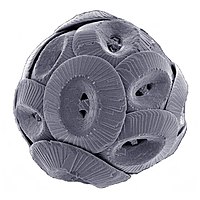
Photo from wikipedia
ABSTRACT Biocementation is a recently developed new branch in geotechnical engineering that deals with the application of microbiological activity to improve the engineering properties of soils. One of the most… Click to show full abstract
ABSTRACT Biocementation is a recently developed new branch in geotechnical engineering that deals with the application of microbiological activity to improve the engineering properties of soils. One of the most commonly adopted processes to achieve soil biocementation is through microbially induced calcite precipitation (MICP). This technique utilizes the metabolic pathways of bacteria to form calcite (CaCO3) that binds the soil particles together, leading to increased soil strength and stiffness. This paper presents a review of the use of MICP for soil improvement and discusses the treatment process including the primary components involved and major affecting factors. Envisioned applications, potential advantages and limitations of MICP for soil improvement are also presented and discussed. Finally, the primary challenges that lay ahead for the future research (i.e. treatment optimization, upscaling for in situ implementation and self-healing of biotreated soils) are briefly discussed.
Journal Title: Geomicrobiology Journal
Year Published: 2017
Link to full text (if available)
Share on Social Media: Sign Up to like & get
recommendations!